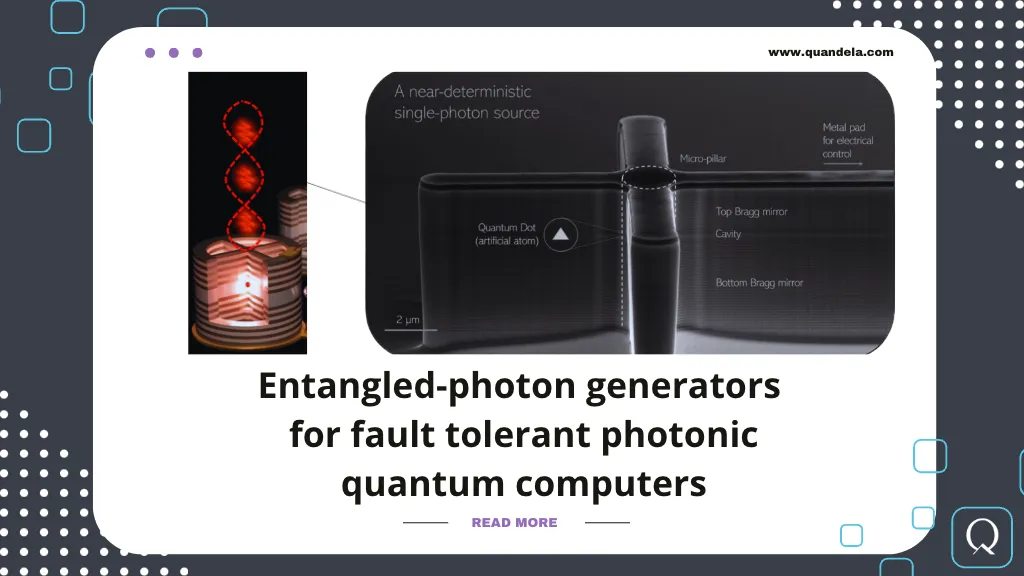Article by Niccolo Somaschi & Pascale Senellart
The scientific results just published in the new issue of the journal Nature Photonics represents another “first” in the technological achievements of the quantum computing company Quandela, towards the development of photonic quantum computers.
Within a collaborative effort, several academic research groups (Pascale Senellart at C2N-CNRS, Sophia Economou at Virginia Tech (USA), Alexia Auffeves at CNRS Grenoble) and the teams in Quandela demonstrate the deterministic generation of a linear cluster state of entangled photons, with a semiconductor quantum dot photonic device.
This work reinforces the already strong bounds within the group of Pascale Senellart at C2N-CNRS and Quandela’s theory and experimental teams.
A semiconductor approach for entangled qubits generation, building on a semiconductor artificial atom and a single spin control.
By entangling a spin embedded in a semiconductor quantum dot, and the photons emitted in a time sequence, the authors demonstrate two and three-partite entanglement with record efficiency with generation rate 100 times and 10 times higher than the previous state of the art across different technologies. This is also the first time (all platforms considered) that such high efficiency is combined with photon indistinguishability — a crucial feature for scaling toward 3D cluster states for fault tolerant quantum computing.
The protocol permits to convert one of the most efficient single-photon generators into an entangled-photons weaving machine at the microscopic scale.
From single photon quantum computing to cluster state-based quantum computing.
The use of cluster states, graphs states and large ensembles of entangled qubits as resource for quantum computing does not represent a new idea.
Several theoretical approaches and protocols have been proposed since early 2000s (MBQC, Ballistic QC, Cluster state string) making the approach, generalised as “Measurement based quantum computing”, as one of the most studied and most explored in terms of scalability for universal quantum computing.
It is in fact well assumed in the scientific community, as well as in the quantum computing corporate world, that the architecture based on the manipulation of large cluster state of entangled particle is among the most viable approaches for error corrected, large scale quantum computers — across all platforms.
In the past years, variations of such MBQC approach appeared in the roadmaps of large photonic based quantum computing companies (Fusion BQC, CV QC), placing photonics among the most promising technologies for the quest of fault-tolerant quantum computers.
Nevertheless, generating photonic qubits, and especially, generating entanglement among them, represents an extremely challenging quest in the community.
Most of the research community as well as the above mentioned companies, implements traditional techniques, as spontaneous parametric down conversion and linear optical circuits, which are probabilistic processes in nature. This automatically leads to extremely costly technological resources and footprint, due to the need of heavy multiplexing of very large number of components on multiple large photonics chips.
Today Quandela reaches a major technical milestone in this framework, presenting the most efficient devices capable of generating cluster states of entangled photons on-demand with a single micrometer size, semiconductor device. This achievement builds on Quandela’s unique approach leveraging a single matter-based qubit, to overcome the scalability barrier of the photonic quantum computing platform.
Semiconductor manufacturability for scalability.
The expertise in mastering the semiconductor technology at the core of the publication lies in more than 20 years’ experience within the research group of Pascale Senellart, C2N, and Quandela’s co-founders team.
Combined with the advances in the device manufacturability developed in Quandela, in terms of throughput, quality and reproducibility, we expect to improve the performance already in the coming months.
All these ingredients will permit to increase the coherence time of the single spin allowing for the generation of larger cluster states with dozen of photons with high multi-partite fidelity.
Within the quantum computing development, this class of qubit generators permits to initiate a new phase where manipulation of single photons, is replaced by the manipulation of entangled photons linear cluster states.
From it, protocols for manipulation and error correction will be implemented to combine the required ingredients for a resource efficient quantum computing architecture.
If you are interested to find out more about our technology, our solutions or job opportunities visit quandela.com






